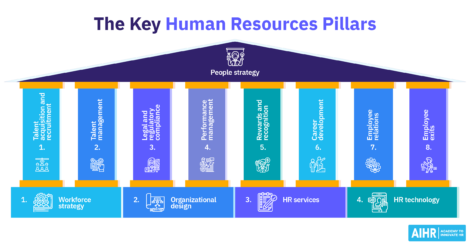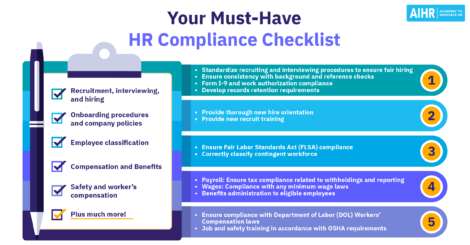HR Audit: Everything You Should Know to Get Started

Is your team conducting regular HR audits? Ineffective HR processes, systems, and policies can hurt your business. If these factors are not continually monitored, a business can find itself on the wrong side of employment laws. Like, facing stiff penalties for not having an employee safety program. Conducting an HR audit helps ensure you are setting your employees and your business up for long-term success and compliance.
Maybe it’s been so long since you’ve participated in an HR audit that you’ve forgotten how beneficial this can be for your organization. Especially as we round the corner in a post-pandemic world, a lot of things can change quickly in a business with its people. This requires taking a quick step back and evaluating where the organization is headed in terms of human capital management.
Contents
What is an HR audit?
Why conduct an HR audit?
When should you conduct an HR audit?
Types of HR audit
7 steps for an effective HR audit process
What is an HR audit?
An HR audit reviews the human resource processes and policies to identify areas that may need improvement and what areas are performing well. Organizations can use an HR audit to ensure compliance and align HR programs with business objectives. They’re making sure that these processes truly contribute to organizational performance.
A human resource audit is akin to an internal process audit. Simply put, it’s like giving your human resource department a report card of how effective it is. Running an audit of your HR department also catches areas of non-compliance to reduce the risk for the business.
Essentially, an HR audit is an opportunity to tighten up processes so that aspects like recruitment, retention, onboarding, training, salary and compensation, payroll, and performance management all get the attention they need.
It might seem like a lot of work. After all, don’t you already have a lot on your plate trying to recruit and retain employees and then making sure they perform? However, continuously improving your HR processes helps you ensure not only that they are compliant with laws and regulations, but also that they help your workforce and your organization become more successful.
Based on an image from Dutch Modern Academy.
Why conduct an HR audit?
The goals of an HR audit are manifold. While not mandatory, every area of HR that is reviewed benefits from having made this effort. According to Mark S. Floyd, partner with the Cleveland law firm Walter and Haverfield, “Audits examine the effectiveness of the HR department’s current policies, procedures, and systems as they relate to the latest changes and developments in labor and employment law.” Moreover, he adds, “senior leadership relies heavily on [the HR] department to ensure that the company’s overall business strategy is consistent with the many complex laws and regulations that govern the workplace environment.”
Not convinced yet? Here are some reasons why HR audits should be a priority at your organization. A thorough HR audit:
- Improves processes and policies that impact employees. An HR audit is a chance to improve areas of your processes and policies that have the biggest impact on employees. This empowers workers, helps retain them, and ultimately makes for a stronger company.
- Ensures corporate compliance. Never take for granted that your policies are compliant with all the laws. There are new employment laws and changes to the laws occurring all the time. In order to get and remain compliant and avoid unwanted lawsuits, you must be ahead of the game with HR compliance audits that identify any potential risk areas.
- Makes HR data meaningful and strategic. Put all that HR data to good use by connecting it with the reality of your HR policies and procedures.
- Helps prevents adverse impact in employment practices. You can mitigate problems with disparate impact on candidates in recruitment, and on candidates in salary and compensation, succession planning, and generally, throughout the employee lifecycle, by doing audits.
- Creates equitable and fair compensation. During your financial audits and compensation analysis, it can also be a good practice to audit how equitable and competitive your salary and compensation packages are. This can support recruitment and retention efforts and also avoid complaints.
- Identifies inefficiencies in systems and practices. At the very least, HR audits can help to discover any practices or systems that are not efficient. Redundant tasks or processes that are too lengthy can cause mistakes to happen.
When should you conduct an HR audit?
Don’t wait for issues to come up before you conduct an HR audit. Taking a proactive approach is always better than a reactive one. Lauren Brown, aPHR, a contributor to the Bernard Health blog, shares, “The best time of year to conduct an audit will depend on the organization’s needs and schedule. A slower time of year might be more productive than the organization’s busy season. Likewise, the end or beginning of the year can help an organization benchmark improvements year over year.”
Choose the time of year that is most convenient for your organization and workload.
Types of HR audit
There are multiple types of HR audit you may conduct, each focusing on a specific area of the organization’s human capital. You can choose to run the audit by creating a committee of internal HR professionals (checking an area they don’t usually handle), or you may decide to utilize a third-party HR audit service.
You can choose to conduct a general HR audit which allows you to assess which people processes at your organization need immediate attention. Download your HR audit template here.
Depending on your organization’s needs, you might want to go more granular. Here are the various types of HR audit you will want to conduct:
Records audit
I-9 audit
Audit aimed at ensuring ongoing compliance with employer sanction provisions of the Immigration and Nationality Act (INA).
Employee files
Are your employee files in a locked and secure location, and digital personnel files encrypted and secure?
Payroll records
Do you maintain detailed payroll records and who has access to them?
Records retention
How long are you storing employee records and are you adhering to the rules for records retention?
HR functions audit
Recruitment and hiring
Do you maintain records of recruitment efforts, from advertisements to interviews and hiring practices? Do you meet Affirmative Action requirements?
Onboarding practices
How new employees are onboarded matters. What kind of structure does your onboarding program have? Do you get feedback from your new hires?
Compensation and salary
Make sure your compensation and salary is competitive, and ensure different groups of employees are paid the same wages for equivalent jobs. Also determine if you are classifying employees correctly as salaried/hourly, full-time employees, part-time workers, or independent contractors.
Performance and training
How do you conduct performance evaluations and what kind of training support is offered?
Legal compliance audit
EEOC
Do you adhere to EEOC guidelines? Are there any potential violations?
Fair Labor Standards Act (FLSA)
Do you comply with FLSA, minimum wage laws?
Family and Medical Leave Act (FMLA)
What is your process for reviewing, approving, and monitoring FMLA requested leaves?
Americans with Disabilities Act (ADA)
Do you offer opportunities to workers with disability in accordance with ADA?
Benefits
Do you offer access to affordable healthcare benefit packages if required? How do you manage COBRA?
Policies audit
Progressive discipline
Is your disciplinary process clear, consistent, and in writing?
Termination policy
Is your termination policy in line with state at-will employment laws?
PTO policy
Do you offer paid time off to all your eligible workers?
Safety audit OSHA hazards Do you maintain an OSHA log? Do you take steps to maintain a safe workplace, including training? MSDS Is your workplace equipped with an MSDS book and do employees know where to find it? PPE Do you provide adequate personal protective equipment, including uniforms as needed?
7 steps for an effective HR audit process
Wondering how to conduct an HR audit? Here is a handy HR audit checklist to get you started:
Step 1: Determine what you would like to audit.
As we’ve mentioned above, there are many different types of HR audits that you can focus on. For this purpose, however, you will want to clearly specify the audit goals for your organization. Don’t try to do everything at once. Set a timeline for completion.
Check out our detailed HR Audit Guide with a downloadable HR audit template to make your auditing process easier.
Step 2: Get buy-in from management.
The only way to make a lasting change that will positively impact your organization is to ensure that you get your executive management team on board. You will need their support, especially if you request to hire a third party to conduct the audit.
Step 3: Determine who will be conducting the audit.
Will you attempt to do the audit yourself, or will you hire outside the organization? Decide who is responsible for what tasks if it is a joint effort. Set expectations for your evaluation from the beginning.
Step 4: Gather the data.
Initially, you will need to collect all the relevant data that has to do with what you are auditing. For example, you can use data from your ATS if you are auditing your recruitment processes. Make sure you have permission to use the data.
Step 5: Review your findings.
Take the time to organize and analyze the information that you have discovered. Try to identify any potential issues and opportunities for improvement. For example, you may prevent future injuries by increasing how often the company orders PPE for workers.
Step 6: Plan and implement your improvements.
First, prioritize the most problematic areas, for example, those that could get your organization into the most legal trouble. Then work your way down your list of priorities to improve processes and policies that are weak and need improvement.
Step 7: Be transparent about the changes.
Employees will be interested to know about the changes and improvements that you’re making to HR processes. Find ways to communicate these changes to them and ask managers to update employees.
Summing it up
Sure, any HR audit can be a complex process that can also be time and resource-intensive. However, the benefits far outweigh the effort. You can redesign your company’s processes and systems that can support business objectives and goals.
Weekly update
Stay up-to-date with the latest news, trends, and resources in HR
Learn more
Related articles
Are you ready for the future of HR?
Learn modern and relevant HR skills, online











